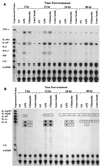Expression of genes encoding Th1 cell-activating cytokines and lymphoid homing chemokines by chlamydia-pulsed dendritic cells correlates with protective immunizing efficacy
- PMID: 11402013
- PMCID: PMC98546
- DOI: 10.1128/IAI.69.7.4667-4672.2001
Expression of genes encoding Th1 cell-activating cytokines and lymphoid homing chemokines by chlamydia-pulsed dendritic cells correlates with protective immunizing efficacy
Abstract
We studied the expression of cytokines, chemokines, and chemokine receptors by the RNase protection assay in chlamydia-pulsed dendritic cells to better understand their potent anti-chlamydial immunizing properties. We found that chlamydia-pulsed dendritic cells express a complex profile of inflammatory and immunomodulatory molecules. These include CCR-7, interleukin-12, and interferon-induced protein 10, molecules that might influence the homing of pulsed dendritic cells to the site of chlamydial infection and the induction of a local protective CD4(+) Th1 cellular immunity.
Figures





Similar articles
-
A live and inactivated Chlamydia trachomatis mouse pneumonitis strain induces the maturation of dendritic cells that are phenotypically and immunologically distinct.Infect Immun. 2005 Mar;73(3):1568-77. doi: 10.1128/IAI.73.3.1568-1577.2005. Infect Immun. 2005. PMID: 15731055 Free PMC article.
-
Differential CD28 and inducible costimulatory molecule signaling requirements for protective CD4+ T-cell-mediated immunity against genital tract Chlamydia trachomatis infection.Infect Immun. 2007 Sep;75(9):4638-47. doi: 10.1128/IAI.00465-07. Epub 2007 Jul 16. Infect Immun. 2007. PMID: 17635872 Free PMC article.
-
Human monocyte-derived dendritic cells expressing both chemotactic cytokines IL-8, MCP-1, RANTES and their receptors, and their selective migration to these chemokines.Chin Med J (Engl). 2000 Dec;113(12):1124-8. Chin Med J (Engl). 2000. PMID: 11776150
-
Contemporary approaches to designing and evaluating vaccines against Chlamydia.Expert Rev Vaccines. 2003 Feb;2(1):129-46. doi: 10.1586/14760584.2.1.129. Expert Rev Vaccines. 2003. PMID: 12901604 Review.
-
Role of chemokines in trafficking of lymphocytes and dendritic cells.Int J Hematol. 2000 Dec;72(4):399-407. Int J Hematol. 2000. PMID: 11197204 Review.
Cited by
-
Chlamydia muridarum-specific CD4 T-cell clones recognize infected reproductive tract epithelial cells in an interferon-dependent fashion.Infect Immun. 2009 Oct;77(10):4469-79. doi: 10.1128/IAI.00491-09. Epub 2009 Aug 10. Infect Immun. 2009. PMID: 19667042 Free PMC article.
-
Prostaglandin E2 modulates dendritic cell function during chlamydial genital infection.Immunology. 2008 Feb;123(2):290-303. doi: 10.1111/j.1365-2567.2007.02642.x. Epub 2007 Aug 3. Immunology. 2008. PMID: 17680801 Free PMC article.
-
Differences in innate immune responses correlate with differences in murine susceptibility to Chlamydia muridarum pulmonary infection.Immunology. 2010 Apr;129(4):556-66. doi: 10.1111/j.1365-2567.2009.03157.x. Epub 2009 Sep 11. Immunology. 2010. PMID: 20102413 Free PMC article.
-
Type 1 T-cell responses in chlamydial lung infections are associated with local MIP-1alpha response.Cell Mol Immunol. 2010 Sep;7(5):355-60. doi: 10.1038/cmi.2010.32. Epub 2010 Jul 12. Cell Mol Immunol. 2010. PMID: 20622889 Free PMC article.
-
A Chlamydia-Specific TCR-Transgenic Mouse Demonstrates Th1 Polyfunctionality with Enhanced Effector Function.J Immunol. 2017 Oct 15;199(8):2845-2854. doi: 10.4049/jimmunol.1700914. Epub 2017 Aug 30. J Immunol. 2017. PMID: 28855311 Free PMC article.
References
-
- Banchereau J, Briere F, Caux C, Davoust J, Lebecque S, Liu Y J, Pulendran B, Palucka K. Immunobiology of dendritic cells. Annu Rev Immunol. 2000;18:767–811. - PubMed
-
- Brunham R C, Peeling R, Maclean I, Kosseim M L, Paraskevas M. Chlamydia trachomatis-associated ectopic pregnancy: serologic and histologic correlates. J Infect Dis. 1992;165:1076–1081. - PubMed
-
- Chow J M, Yonekura M L, Richwald G A, Greenland S, Sweet R L, Schachter J. The association between Chlamydia trachomatis and ectopic pregnancy. A matched-pair, case-control study. JAMA. 1990;263:3164–3167. - PubMed
MeSH terms
Substances
LinkOut - more resources
Full Text Sources
Other Literature Sources
Medical
Research Materials

